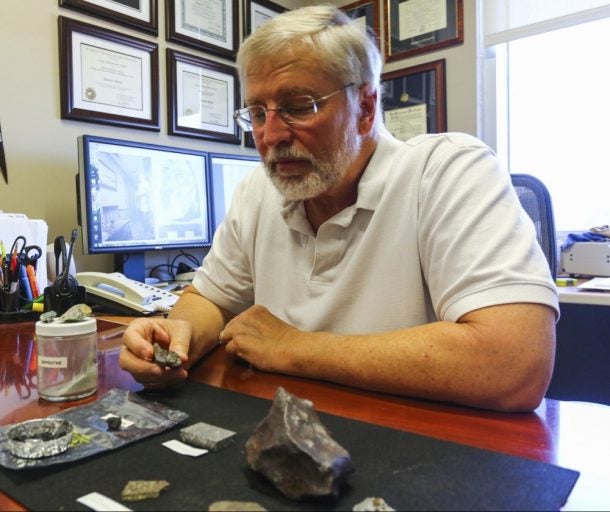UCF has diligently and methodically been making a name for itself in the world of planetary exploration, and it’s beginning to pay off in big ways.
Not only are two UCF professors part of the upcoming NASA OSIRIS-REx mission to collect asteroid samples – a first for the United States scheduled for launch Sept. 8 – but scientists are playing critical roles as NASA and private space companies race to get people back into space.
Recently UCF physics professors Dan Britt and Humberto Campins were named to a team of NASA experts who analyzed an idea for the Asteroid Redirect Mission (ARM) before NASA puts it out for bid. It’s a very select process to be named to one of these think-tank-type teams and practically unheard of to have two individuals from the same university named to the same team. Only Arizona State University – considered by some as the university leader for planetary science in the nation – has achieved this feat, until now.
“Other than Arizona, I can’t think of anywhere else that has this level of expertise,” said Phil Metzger, a scientist at the Florida Space Institute, which is based at UCF. He worked on several NASA missions until 2014, when he moved to FSI where he works with many of UCF’s space scientists.
NASA recognized UCF’s expertise in 2013 when it made the university the base for the Center for Lunar and Asteroid Surface Science (CLASS), one of nine virtual institutes NASA funds to focus on questions concerning space science and human space exploration. CLASS finds itself in a unique position because its experts happen to be in hot demand as NASA and private space companies prepare to send people to other planets.
“NASA is starting to get serious about Mars, so they are looking to do more research in the area of airless bodies [asteroids and planets with barren surfaces] as part of the highway to Mars, and that’s where we come in,” said Dan Britt, the UCF geophysicist who leads CLASS. “We are a virtual institute that is a compilation of skills that look at surfaces of airless bodies like asteroids and the moons of Mars. We look at everything from dust to microgravity. We offer the best scientific advice so the engineers at NASA can design the hardware needed to keep people alive in these alien environments.”
Members of CLASS at UCF are creating asteroid simulant (asteroid fake dirt) to help private companies and NASA develop the machinery and protocols to mine minerals and other resources from asteroids. Some of the team members are studying how dirt interacts with microgravity in anticipation of spacecraft approaching and landing on other planets.
“Space exploration isn’t cheap,” Britt said. “There are some real challenges and that takes money. Since putting a man on the moon, NASA has been underfunded. It’s no surprise we haven’t done more that’s exciting for the American public since then.”
Britt sees private companies entering the field of space exploration as a great catalyst.
“I think it’s a good thing to have competition of new ideas,” he said. “With big innovators who are willing to spend money and aren’t so worried about public perception of setbacks, it’s really jump-started this again.”
Commercial space entrepreneurs such as Elon Musk of SpaceX and Jeff Bezos of Blue Origin have poured millions of dollars into their programs to develop vehicles that can get people back into space since the shuttle program retired in 2011. They’ve had some public mishaps, but they’ve also created two vehicles that in just a few years are on the cusp of meeting their objectives.
Professor Josh Colwell, who is also a CLASS member, is taking advantage of the opportunities provided by these private companies, too. Colwell has had two experiments fly aboard the new spacecrafts developed by SpaceX and Blue Origin.
“It’s a great way to get experiments completed quickly,” Colwell said. “And what we’re learning can really help us answer how our planets were formed. That will help us understand what we encounter as we begin to explore other planets.”
Britt and UCF professor Humberto Campins, who is prepping for the unmanned OSIRIS-REx mission launch in September, are eager to see the NASA’s request for proposal for the ARM, which they evaluated for NASA.
ARM aims to send a spacecraft to a nearby asteroid, pluck a 10-ton boulder from it, and then take it to the moon’s orbit. According to NASA, ARM will help develop a number of new technologies and capabilities that will directly enable future missions to Mars.
According to NASA, a human mission to and from the Mars system could last two years, or longer, including six to nine months of transit each way. Unlike trips to the International Space Station, there is no quick way home. Those missions will have to be independent of Earth and its resources.
“I think CLASS is in a perfect position to help us get there,” Britt said. “That’s what keeps us excited to be in this. It really is quite the adventure.”
